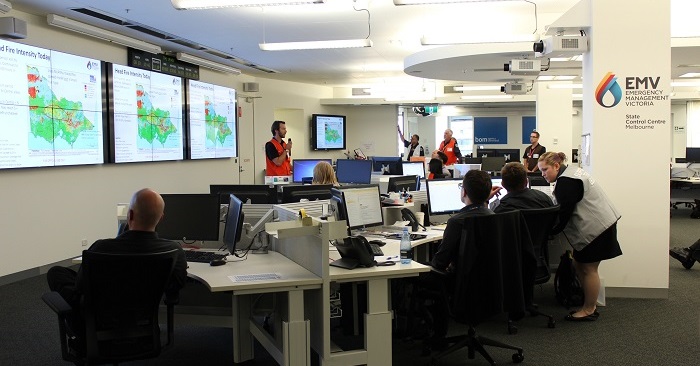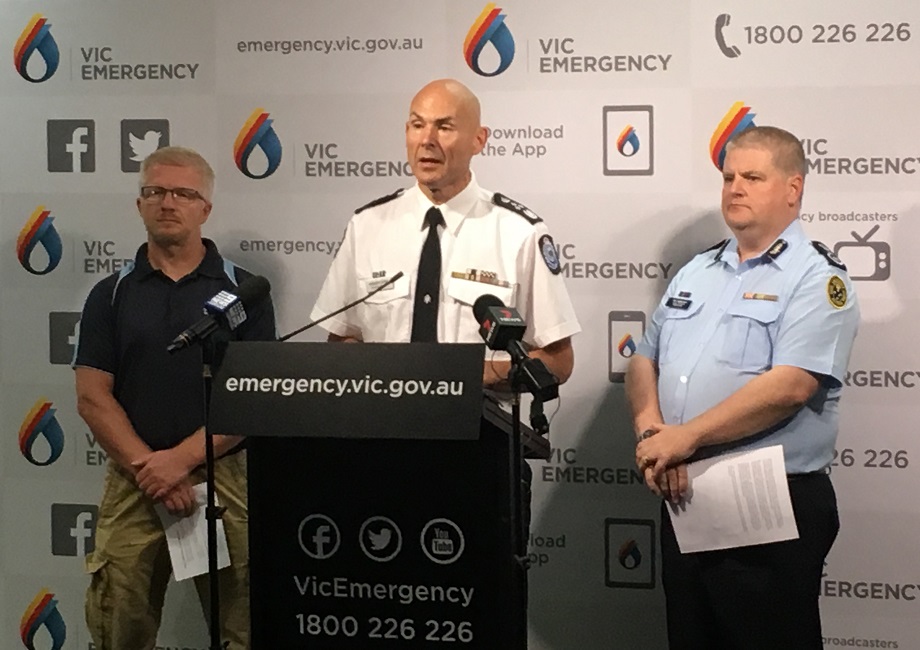Weather and emergency management: behind the scenes at Victoria’s State Control Centre
17 May 2017
Around Australia the Bureau’s meteorologists work closely with emergency managers. They provide weather information to inform planning and decision-making at times of emergency—and to assist with management activities throughout the year. In Victoria, Kevin Parkyn works as our embedded meteorologist within the State Control Centre (SCC). He tells us about his role there.
Victoria's State Control Centre is operated by Emergency Management Victoria (EMV). The SCC is Victoria’s primary emergency control centre, connecting the Victorian community with regional and incident controllers during major emergencies. It is both a facility and an organisational arrangement for State-level coordination of emergencies—primarily fires, floods and storms.

Image: A briefing at Victoria’s State Control Centre. Credit: EMV
What services do you provide?
I provide weather briefing services to a number of different audiences within the emergency services sector. These include the heads of emergency response agencies such as the State Emergency Service, the Country Fire Authority, Victoria Police, Ambulance Victoria, and the Department of the Environment, Land, Water and Planning. A key function of my role is to communicate the risk of significant weather occurring or of weather influencing emergency agency operations.
What hours do you work?
I’m at the State Control Centre year-round. From November to April,when Victoria sees the most severe weather, I work rostered shifts of around 12 hours a day. I start at 7.00 am—often earlier on significant weather days—to prepare for the first briefing to the State Control Team at 7.30 am.
How do you convey information to those who need it?
I give face-to-face briefings to the State Control Team, as well as online presentations for anyone in the emergency management community, about what’s happening now and what’s coming up on the weather front. I share and explain weather modelling information and generally act as a resource for decision-makers within the sector. As well as the severe weather that brings fire, flood and damaging winds, this can be in relation to year-round fire-management activities—for example, phone discussions about ‘weather windows’ for planned burns and any risks involved. Press conferences are often held at the SCC leading up to, during or following a significant weather event. In conjunction with representatives from emergency management agencies, I am sometimes required to provide the media with an update on the weather.

Image: Press Conference at the Victorian State Control Centre, 15 December 2018. L–R: Kevin Parkyn, Andrew Crisp (Emergency Management Commissioner) and Tim Wiebusch (Victoria State Emergency Service Chief Operations Officer).
How does a typical day start?
'Hit the ground running' is a good way to describe it. I’ll quickly ascertain the current weather situation and what has occurred overnight, then review the early morning issue of forecasts and warnings, picking up on any notable updates or changes—like any observations that might trigger us to believe severe weather has become more likely. Or, if a heavy rain event is unfolding, I’ll be watching the satellite and radar and comparing them with our modelling to make sure we have the richest understanding possible of the likely course of that event.
Does your role change on days when major fire emergencies develop?
Yes, it shifts from communicating weather with a focus on preparation for what could happen, to analysing the current situation and weather influences on fire behaviour. For instance, I’ll be monitoring the radar in an area we know there’s a fire. If the fire shows up on the radar it means there’s a significant convection column above it that could become ‘pyro-convective’, which means it generates a towering cloud above the smoke column that could grow into a thunderstorm. This kind of fire is harder to suppress and poses a greater risk to life and property.
I’ll also be working closely with the fire behaviour analyst—who looks at landscape characteristics and information on fuel conditions, as well as forecasts/actual weather to predict how the fire is likely to develop. At the same time I’m liaising with the Bureau’s operational meteorologists (who produce Victoria’s forecasts and warnings)—especially during significant fire events when critical details like timing of wind changes are communicated. The meteorologists factor this first-hand intelligence on the status of fires and the priority incidents being managed by the emergency services into their activities.
What’s the most rewarding part about working at the State Control Centre?
For me it’s communicating weather information that influences decision-making and prepares the emergency services leading up to significant weather days. Ultimately this makes the community safer and more resilient. Witnessing in real time how weather intelligence that I communicate directly influences decisions by emergency managers is hugely satisfying professionally. Working in a multidisciplinary team with other technical specialists such as flood analysts, fire behaviour analysts and geographic information system analysts is also very interesting.

Subscribe to this blog to receive an email alert when new articles are published.


Comment. Tell us what you think of this article.
Share. Tell others.